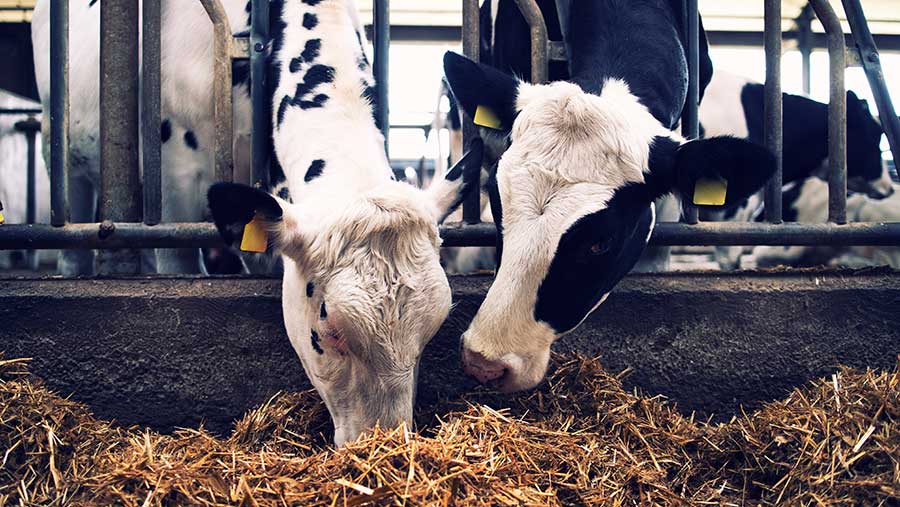Costed herds perform despite hot summer and high input prices
 © Littlewolf1989/Adobe Stock
© Littlewolf1989/Adobe Stock Margins over feed costs reached highs across the board in the year to 31 March 2023 for Kingshay costed dairy herds.
The average margin over purchased feed (MOPF) was £2,865 a cow and 33.87p/litre, with all systems far exceeding the previous year’s £1,920 a cow and 22.71p/litre averages.
These were the most positive results since the series began in 1998, in terms of both margins and efficiency, said Kathryn Rowland, senior farm services manager with Kingshay.
Year-round housed units produced the highest margin a cow, with low- to moderate-yielding organic herds leading on a pence-per-litre basis.
See also: Advice for farmers as HMRC steps up IHT relief claim investigations
However, the widening of the gap between the top 25% performers and those in the lower 25% bracket continued.
Price and performance gaps
“The gap between the top and bottom quartile of those within the same systems widened again, showing the potential to improve performance within an existing system rather than switching to an alternative,” said Kathryn.
Benchmarking against similar farms would help with this, alongside focusing on meeting the requirements of milk contracts, she suggested.
The gap between the top 10% and bottom 10% of prices reached a peak differential of 16.2p/litre in February, with producers in Scotland suffering the worst prices on a regional basis.
Feeding 3,197kg over the milk year, the bottom 25% of producers used 917kg more concentrate a cow than their higher-performing counterparts.
The average gap in MOPF/litre for the top and bottom quartiles of grazing-based herds widened from 8.7p/litre last year to 12.9p/litre in 2022-23.
In the mainly housed herds, where the focus is on margins a cow, the gap widened from £705 to £980 a cow.
Yields static
Ten-year trends show herd size continuing to grow, but yields stagnating since 2020, averaging 8,458 litres a cow in 2022-23.
This was possibly down to a greater effort to improve herd health and reduce cow stress rather than focusing on production alone, said Kathryn.
The hot summer of 2022 meant milk from forage dropped a few litres, to average 2,776 litres a cow, although some organic and top-performing conventional herds maintained performance on this measure.
The weather also affected fertility, with cows not displaying obvious oestrus cycles.
This pushed average days to first service from 69 to 75, with high milk prices leading to a £5.89 a cow a day cost for the longer calving interval.
Heifer trends
The annual report included heifer trends for the first time and found 62% of herds not hitting the age at first calving target of 23-25 months.
Also, just over half of cows left the herd in their first three lactations, before they had fully paid for the cost to rear them.
“This can have a big effect on carbon footprints,” said Kathryn. Fertility accounted for 24.9% of cows leaving the herd
Outlook
Milk prices have already lost more in the first half of 2023 than they gained in the second half of last year.
Concentrate prices are still relatively high and virtually all other costs are up, so budgets are looking challenging, said Kingshay development director Richard Simpson.
“The milk price is a lot lower and it’s an uncertain outlook. There’s also an environmental challenge on the horizon, with slurry investment needed.”
Kingshay costed herds – key points
Year ended 31 March 2023
- Average herd size 217 cows compared with UK average of 160 cows (England 166, Wales 164, Scotland 208, Northern Ireland 124)
- Analysis of five conventional systems – spring calving, block calving (grazing focus), block calving (housing focus), year-round calving (grazing focus), year-round calving (grazing focus) as well as two organic models – low/moderate yield and high yield
- Top per-cow average margin over purchased feed (MOPF) of £3,058 achieved by block-calving herds with housing focus
- Top per-litre average MOPF of 39.71p achieved by spring-calving herds
- Highest milk yield from all forage in organic herds – 3,302 litres in high-yielding organic group
- Highest milk yield from all forage in conventional herds – 3,219 litres in block-calving herds with housing focus
